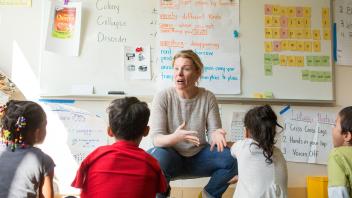Teacher question
Shanahan’s response
I receive few letters on this, but when visiting schools this confusion is often apparent. Teachers either ignore the level specifications of the standards or assume that teaching kids at “level N”, as they have been doing, must be the best way to reach the standards levels. As one young teacher said to me, “The standards can’t mean that we are supposed to teach with harder books. These are hard enough.”
1. Have kids read a lot within instruction
Students should be reading and writing during reading lessons — and during social studies, science, math, and health lessons, too. Too often the reading lesson time is just talked away, but kids need to read when there is a teacher there to monitor and support their reading. Perhaps set an arbitrary target: kids will read 50% of the time during reading lessons; or they will read at least 4 pages of mathematics or 8 pages of science per week. Lots of reading of lots of texts; every day; every week; every year.
2. There is no instructional level
Despite claims by authorities in reading and special education, no procedure for matching texts to kids has been found to reliably provide any learning advantage. Kids can learn from harder books than we have taught with in the past—but that means more scaffolding. Don’t limit kids’ reading to texts at their “instructional levels” (~95-98% accuracy in fluency; 75-89% comprehension), or to any of the new levels now being advanced (90-95% accuracy).
3. Vary the difficulty levels
Past claims about the instructional level made it sound like you would harm kids if you taught them in books that were “too easy” or “too hard” and so the notion was that all the productive reading work would be done at the instructional level. I suspect that learning to negotiate the complexities of text is probably more like learning to run faster or to swim farther. Athletes don’t do all of their training at one level of difficulty or intensity. They vary routines to build strength and stamina, and I think we should do the same with reading. The texts we use to teach reading should vary in difficulty and length—with kids reading some hard texts, followed by easier ones, followed by even more difficult ones. Text difficulty levels should go up and down, but the average difficulty over time should climb. And don’t be afraid to go beyond the level that your grade level is supposed to reach: if third-graders are supposed to learn to read 820 Lexiles, 820 is not the highest level text we should introduce.
4. Be prepared to give more help when more help is needed
I’ve criticized our programs before for providing the greatest help when kids are asked to read easy texts and the least support when they take on the hardest ones. If I’m weightlifting with light weights, I don’t worry much about having a spotter. But if I ‘m trying to push myself to the limit with heavier weights or a greater number of reps than I’m used to, I want assistance. So why do kids work in small groups with a teacher when reading relatively easy texts and we save our harder texts (like the science book) for whole class instruction?
5. Try to anticipate why a text will trip kids up and then question them watchfully
What do I mean by watchfully? Question them in ways that will reveal whether they figured out what you thought was complex. I know you already ask questions about the overall meaning of the story or article, but I’m suggesting even closer questioning than that. For instance, if you think a sentence is complicated, ask a question that depends on making sense of that sentence. If you are concerned that kids will miss a confusing cohesive link or an implied causal connection or a subtle sarcastic tone, then probe those things. If they are tripped up, then take them back to the text to figure out how it works.
6. Require rereading
The more challenging a text is, the more it has to be reread. Reading it once (or twice) to figure it out, and then reading it again without so much support can really improve one’s reading ability. Yes, it takes extra time, but time that pays learning dividends. Such rereading does not need to be done immediately. It is okay to go back to a selection that one read last week or last month (though the longer the interval, the greater amount of teacher support that will likely be required on a reread).
You are, indeed, supposed to teach kids in harder texts than you have been teaching them. Keep these six guidelines in mind and you’ll do a better job of that.
About the Author
Literacy expert Timothy Shanahan shares best practices for teaching reading and writing. Dr. Shanahan is an internationally recognized professor of urban education and reading researcher who has extensive experience with children in inner-city schools and children with special needs. All posts are reprinted with permission from Shanahan on Literacy .

